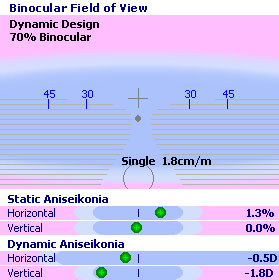Meridional anisometropia. Age 45.
| Sphere | Cylinder | Axis | Add | PD | |
| OD | +0.25 | -0.25 | 10 | 1.50 | 30 |
| OS | +0.25 | -3.25 | 12 | 1.50 | 31 |
| BU | BD | BI | BO | ||
| 2 | 2 | 4 | 10 |
| Eye | DBL | Wrap | Vertex | Height | |
| 52 | 17 | 6 | 12 | 21 |
At first glance, this Rx would not attract the attention of the attending OD as both sphere values are equal. Of clinical interest in this case of anisometropia due to monocular astigmatism is the dynamic aniseikonia created in the vertical meridian. The SHAW method optimizes the design to reduce the prismatic effect induced vertically by the eyeglasses. It does this through a combination of corridor length and base curve optimization.



Dynamic aniseikonia is a major contributor to headaches and vision fatigue. Even though this patient had minimal aniseikonia laterally, there was substantial improvement with vertical dynamic and static aniseikonia with the SHAW lens.
Patient testimonial
After wearing them all day today, I am still experiencing the increased clarity, and I have also become aware that I do not have the ‘end-of-the-day headache’ or tired eyes that I have become so accustomed to. My eyes feel more relaxed.
I was worried that the left lens would be thick and ugly, but in the plastic frame the thickness is not noticeable.”
– K. Roberts